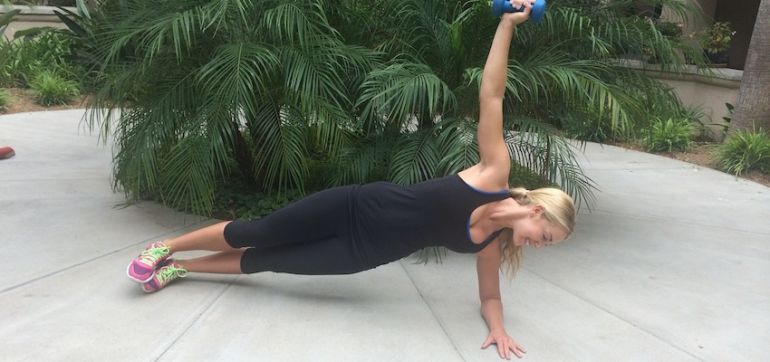Whats Best For Losing Fat Aerobic Exercise Vs Weight Training
Resistance is not Futile
We all know that to lose weight requires a combination of corrective eating & exercise?but if only it was that simple.
Within both ?worlds? of dieting and exercise there are literally countless alternatives and conflicting theories that most people struggling to lose weight often get confused, disheartened, and unfortunately, usually just give up trying to find an approach to follow.
Focusing on exercise, in most gyms today, you will no doubt find numerous pieces of cardio or aerobic apparatus - stationary cycles, recumbent cycles, treadmills, and different types of stationary stair climbing machines being the most common, and if you are brave enough to go into a gym on any given Monday, you will also probably find endless queues of members lining up at each cardio machine station, waiting their turn to ?burn off? the Weekend's indulgences.
And here we have the ?first ?rule? of exercise-for-fat-loss - that to burn fat, requires an emphasis on endurance-type, cardio or aerobic exercise ? i.e. a minimum of 20 minutes of continuous cardio activity. The 'second rule? of fat burning is that we need to get into the ideal ?fat burning zone? ? approx 60%-70% of our MHR (Maximum Heart Rate ? calculated by subtracting your age from the number 220) ? and maintain this level for the duration of the cardio session.
Based on these two ?rules?, most people trying to lose weight can be forgiven for thinking that to lose more weight, they must simply extend the duration of their exercise sessions ? the logic being that if 20 minutes is good?45, 60, or even 90 minutes must surely be better? The longer the session, the more fat will be lost?
However, this is exactly the WRONG thinking'thinking that may not only lead to potential overuse injuries, but may also lead to slowing down of weight loss.
Another classic misconception within the world of exercise, is separating cardio activities from resistance or weight training. Most gym trainers or exercisers see the 2 disciplines as separate entities, believing that resistance training ?works the muscles? and cardio training ?works the heart & lungs and burns fat?. Hence the typical combination of weight training and low-intensity aerobic exercise being a popular approach prescribed for losing weight. It may be a popular approach ? but it is certainly not the best or most effective approach.
One Set Of Muscles ? 2 Different Tasks
First we need to understand one thing. Our bodies have a single muscular system. We do not have one set of muscles for aerobic or cardio work, and another, different set for resistance training. We have a single set of muscles that we use differently. So although we may think that a cardio workout focuses on our heart and lungs, it is the muscles (usually the legs) that are doing the primary work (the leg muscles contracting against a relatively light resistance for an extended period). Similarly, progressive resistance training done with sufficient intensity can place very high demands on the cardio system.
So it is important to not separate the ?cardio? and ?weights? when thinking about exercise. What is important though, is to look at the reason for exercising in the first place. This will then dictate which approach to exercise is best and most suitable. Most people exercise to control or lose weight. Some want to get into peak physical condition, others want to add muscle to their frames, and still others want to just maintain a good level of general fitness.
Once you have identified your exercise objectives and goals, you can then look at putting together a weekly exercise plan that meets these goals.
For this article, we'll look at 2 alternatives?An approach for ?Purely weight loss?; and an approach for ?General fitness?. There are obviously many other options, but we will look at these in another article.
Purely Weight Loss
If your reason for exercising is purely to lose weight, then you need to rethink your approach completely.
The first and most important step to remember is this?..
Exercise is best used to prevent weight gain?a corrective eating plan is best used to initially lose weight.
Now, naturally there is merit in doing both at the same time, and we'll discuss how to do this shortly. However, depending on how much weight you need to lose, an exercise program may place too much stress on the body in the early stages of a weight-loss program, especially if done at the same time as dieting. The reason for this is that the body responds to extreme physical changes as a stress. If you suddenly reduce your daily calorie intake, your body reacts as if it under stress and ?holds on? to weight the same way it would if you suddenly moved to a very cold climate. Similarly, if you suddenly started an exercise program, the body perceives the change as a stress. It is wise then to start with a gradual corrective eating plan. Once this is in place, gradually begin an exercise program?.EXCLUDING aerobic activity. The key reason for this is because as mentioned earlier, the body reacts to dieting as a stress, and ?holds on? to its fat reserves. This is why when dieters begin a diet they feel that they have lost a lot of weight, however this initial weight loss is usually water. The body next 'sacrifices? muscle tissue, burning muscle tissue and only then starts to utilize its fat reserves. By starting an exercise program with mild resistance training, you will preserve and strengthen your muscle mass encouraging the body to utilize its fat stores. Well-conditioned muscles are key to assisting in weight loss, as your resting metabolic rate (RMR) is largely determined by how much muscle you have. So to lose muscle will almost guarantee a slowing down of your metabolism.
The key is that the resistance program must be light initially and build progressively. Also, each session must work the full-body, initially with one light set per body part with sufficient rest between each rest. When starting out, a twice a week program is best, and this can increase to three times per week as fitness improves.
Once general fitness increases, the next step is to GRADUALLY increase the intensity level of each workout by gradually increasing the weight of each exercise, and also reducing the amount of rest between each set ? the exercises can remain the same.
Suggested 10 Exercise Routine:
Leg Extensions Leg Press Hamstring Curls Bench Press Lat Pulldowns Shoulder Press Seated Row Triceps Pushdowns Biceps Curls Stomach Crunches
When fitness and strength levels begin to improve (not sooner than 2-3 months), a cardio program can also be included to the weekly schedule to assist with fat loss, however, not the typical low-intensity/long duration aerobic approach.
The best route for cardio is to approach it as a resistance workout, and to think of ?burst & rest? when doing cardio. To start off, only do a maximum of 15-20 minutes ? no more than that ? and alternate 2 minutes of low-intensity, with 30 secs of higher-intesnity. As your fitness gradually improves, increase the intensity and gradually reduce the lower-intensity intervals ? i.e. 1 minute lower-intensity, 1 minute higher-intensity, 20-30 secs recovery. Your total cardio session should not ever exceed 20-25 minutes, and ALWAYS increase intensity levels gradually ? NEVER push yourself hard until you achieve a relatively higher level of conditioning. In terms of frequency, aim to do the cardio routine 2-3 times week, and not on the same day as the resistance routine.
Naturally, the results of your training will be largely determined by your eating program ? if you ignore your diet, the program outlined above will not produce ideal results.
General Fitness
For those who are just ?out of shape? and are just keen to maintain a general level of all-round fitness, it's best to aim to make exercise sessions as multi- faceted as possible, to aim to cover most areas of fitness in a single workout. For those looking to maintain a general level of fitness, time spent exercising should be as economical as possible ? to get maximum exercise value out of each session.
Ideally, each session should include an element of cardio training, strength training and general conditioning, and should not take too long in duration.
Circuit training is the answer here ? and most gyms have at least one, if not two varieties of circuits. Circuit training ? done correctly ? can be a very demanding form of exercise as by definition, it combines both resistance and cardio training aspects.
The key lies in HOW to use the circuit properly to gain maximum benefits.
Most circuits have a timer buzzer (and colored light system) that in most cases buzzes to signal when to move from one exercise station to the next. There is also 10-15 second gap to allow for setting up/adjusting each station before the next buzzer goes to signal when to commence the set.
Most trainers tend to approach circuit training with a very low-intensity approach, taking full advantage of the time allowed between sets, and also using very light resistance on the machines
To improve general fitness levels, it is better to use challenging resistance levels, and also limit the rest period between each station. When the buzzer goes to change exercise stations, it is better to move quickly and start the set immediately, before the buzzer goes off that signals the START of the set. Then perform the set and only react to the buzzer that signals the END of the set, again, moving swiftly to the next station and commencing immediately. Also, keep resistance levels at a level that is challenging and aim to do 12-15 reps at a slow pace (as opposed to the usual high-rep approach associated with cicuit training). If your gym has different circuits, then alternate the circuit, but ensure that you apply the same approach to each circuit. Remember, aim to keep rest periods between exercise stations as short as possible, and use controlled form on the resistance machines, going for challenging resistance that allows a maximum of 15 reps. If you can do more reps within the allowed time, then the resistance is too light.
After doing the circuit, end off with 2 supersets of pushups & chin-ups, performing maximum reps (i.e. 1 set of pushups, immediately followed by 1 set of chin-ups ? rest and then repeat), and then cool off with some light stretching.
This routine will provide a solid cardio base of general fitness and good strength levels and will ensure an above-average level of allround conditioning.
-
A Solid Plan to Lose Belly Fat
There are many ways to lose stubborn bel
-
Why Dont Our Bodies Want To Lose Fat?
Many people know how frustrating it is w
-
Why Taking Baby Steps Is The Best Way To Improve Your Health
-
Losing Weight Naturally – The Honest Truth About Cardio…
While its undeniable that any form of exercise is better than no ex
-
On This Page We Are Going To Be Looking At The Eat Stop Eat Program
For those of you who have been looking t
-
Reviews Of The Cayenne Pepper Diet
Does the cayenne pepper diet actually work? Are their any major side e
- DON'T MISS
- Understanding Adult Obesity
- Asian Diet Advice – Get Thin Fast Without Crazy Exercises!
- Fat Loss 4 Idiots Review – They Tell It Like It Is!
- The Psychology Of Weight Loss Part 1 The INSIDE OUT Mindset
- 3 Powerful Weight Loss Exercises Anyone Can Do
- Food Addicts Anonymous Weight Loss Review
- How To Keep Your Body's Weight Loss Momentum And Lose More Pounds
- Success Guide To Fat Burning Muscle Building Workouts
- Eating for life!
- Why Do Water Aerobics Routines




